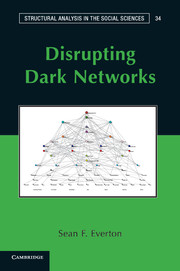Book contents
- Frontmatter
- Contents
- Figures
- Tables
- Preface
- Acknowledgments
- Part I Introduction
- 1 Social Network Analysis: An Introduction
- 2 Strategic Options for Disrupting Dark Networks
- Part II Social Network Analysis: Techniques
- Part III Social Network Analysis: Metrics
- Part IV Social Network Analysis: Advances
- Part V Conclusion
- Appendix 1 The Noordin Top Terrorist Network
- Appendix 2 Glossary of Terms
- Appendix 3 Multidimensional Scaling with UCINET
- Appendix 4 The Just War Tradition
- References
- Index
2 - Strategic Options for Disrupting Dark Networks
Published online by Cambridge University Press: 05 April 2013
- Frontmatter
- Contents
- Figures
- Tables
- Preface
- Acknowledgments
- Part I Introduction
- 1 Social Network Analysis: An Introduction
- 2 Strategic Options for Disrupting Dark Networks
- Part II Social Network Analysis: Techniques
- Part III Social Network Analysis: Metrics
- Part IV Social Network Analysis: Advances
- Part V Conclusion
- Appendix 1 The Noordin Top Terrorist Network
- Appendix 2 Glossary of Terms
- Appendix 3 Multidimensional Scaling with UCINET
- Appendix 4 The Just War Tradition
- References
- Index
Summary
Introduction
Given the time and energy that has been devoted to the collection of data on dark networks (see, e.g., Koschade 2006; Krebs 2001; Rodriguez 2005; Sageman 2004, 2008; van Meter 2001), it is surprising that little attention has been paid to exploring strategies for their disruption (Roberts and Everton 2011). Strategies for combating them are poorly documented in the literature, and with one exception (Lempert et al. 2008), little or no research compares alternative strategies with a view of balancing potential gains and costs. Moreover, it appears to be almost an article of faith that once a dark network's structure has been mapped and its key members identified, one is supposed to capture and eliminate designated high-value targets. However, as noted in the preface, while targeting key players is one option to consider (Walzer 2009:274), other options exist that may offer better alternatives when taking into account costs, human lives, and the consequences for affected communities (see Chapter 12).
This chapter argues that various strategies for countering dark networks need to be considered prior to the use of formal social network analysis. It begins by distinguishing between two general approaches to countering dark networks: kinetic and nonkinetic. The former involves aggressive and offensive measures designed to eliminate or capture network members and their supporters, while the latter involves the use of subtle, noncoercive means designed to reduce a network's effectiveness and impair a combatant's will to fight. This chapter then moves to an overview of the process through which analysts can generate strategies for disrupting networks, a process that involves the drafting of working hypotheses, the identification of relations of interest, the aggregation and/or parsing of these networks, the exploratory analysis and interpretation of the networks, and a revisiting of the original hypotheses. The chapter then concludes with a brief reflection on the proper uses of SNA for the disruption of covert and illegal networks.
- Type
- Chapter
- Information
- Disrupting Dark Networks , pp. 32 - 46Publisher: Cambridge University PressPrint publication year: 2012
- 1
- Cited by



